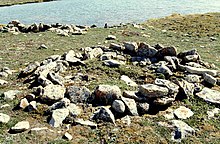Thule people
The Thule (pron: too-lee) were the ancestors of all modern Canadian Inuit. They arrived at Alaska in around the year 500 and Nunavut, Canada in 1000. A subgroup then moved east to Greenland by the 13th century. The appellation of "Thule" originates from the location of Thule in northwest Greenland, facing Canada, where the archeological remains of these people were first found [1]. The links between the Thule and the Inuit are biological, cultural, and linguistic.
The Thule subsisted both on marine and terrestrial animals. They replaced the Dorset culture by the early fifteenth century.

The Thule winter settlements usually had one to four houses with around ten people. Some major settlements may have had more than a dozen houses, although not all were inhabited at the same time by the fifty residents. Their houses were made of whale bones from summer hunts. Other structures include kill sites, caches, and tent encampments.
Some Thule migrated southward, in the "Second Expansion" or "Second Phase". By the thirteenth or fourteenth century, the Thule had occupied an area currently inhabited by Central Eskimo. There is good evidence to support the idea that the Thule (and the Dorset, but to a lesser degree) were in contact with the Vikings, who touched the banks of what is now modern Canada in roughly 1000 AD. However, intensified contacts with Europeans began in the 18th century and, compounded by the already disruptive effects of the "Little Ice Age" (1650-1850), the Thule communities broke apart and the people were henceforward known as the Eskimo and, later, Inuit.
